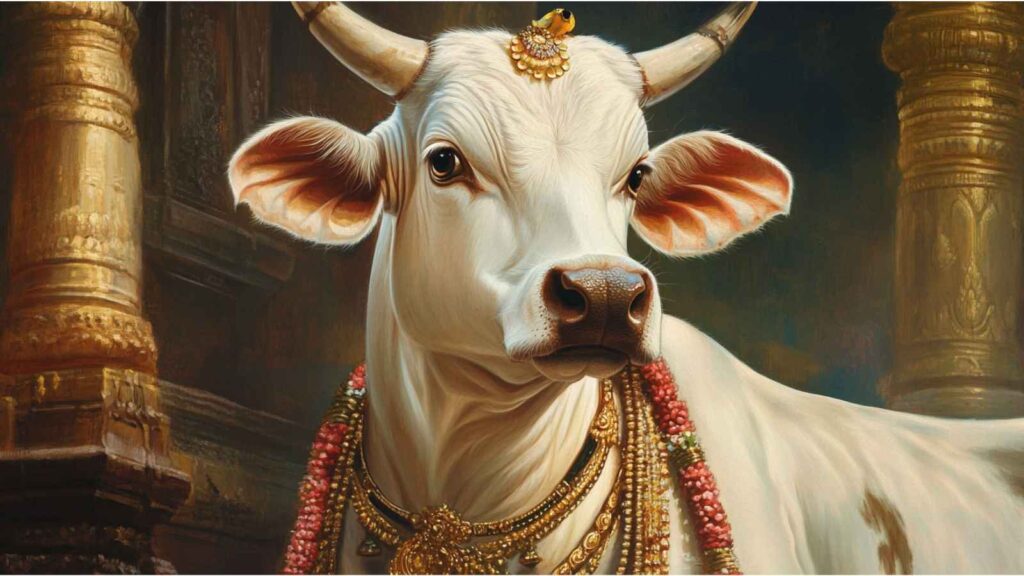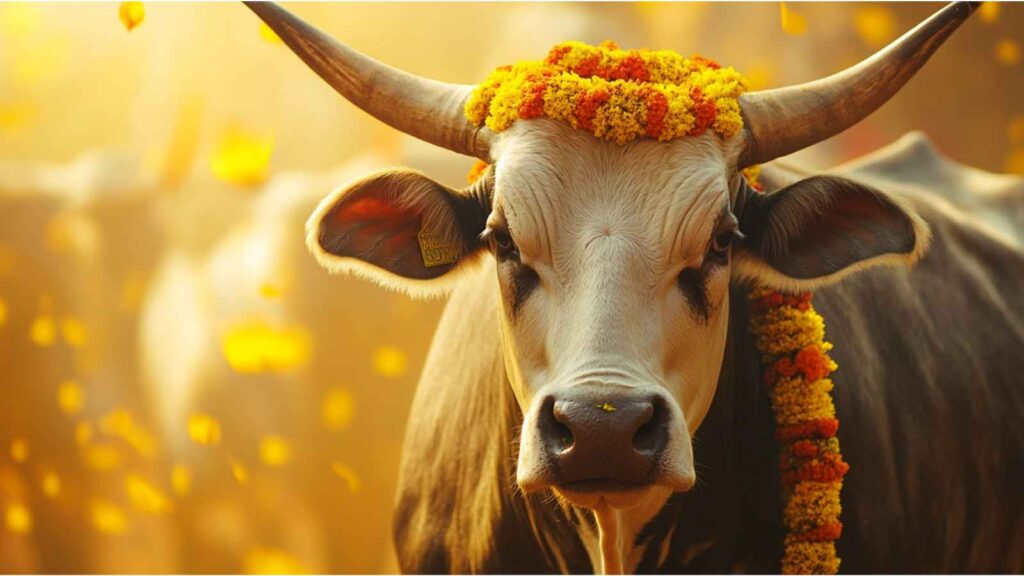Gau Mata: The Sacred Cow in Hinduism – History, Temples & Spiritual Legacy
Hinduism is renowned for its rich tapestry of beliefs and traditions, where every element of nature is imbued with spiritual significance. Among these, the cow – revered as Gau Mata (Mother Cow) – holds a special place in the hearts of millions of devotees. Symbolizing non-violence, abundance, and maternal care, the cow is an enduring emblem of life and sanctity in Hindu thought. Rooted deeply in the ancient scriptures such as the Vedas, Upanishads, and the Bhagavad Gita, the reverence for the cow transcends ritualistic practices and permeates the cultural and ethical fabric of Hindu society.
Read More About Hindu Philosophy
This blog post delves into the profound significance of Gau Mata as a sacred animal, exploring her representation in foundational texts and her embodiment in revered temples. We will journey through history and tradition to understand how cow worship evolved into a symbol of divine nourishment and compassion. In addition, we present detailed profiles of three prominent cow temples—each with an exact location, historical background, architectural highlights, and an overview of the visitor experience. Finally, we outline an AI image creation framework to help you generate captivating visuals that complement this content and further enhance your SEO efforts.
The Sacred Significance of the Cow in Hinduism

Spiritual Symbolism and Scriptural Foundations
In Hinduism, the cow is more than just an animal—it is a divine symbol of motherhood, sustenance, and selfless giving. Ancient scriptures extol the virtues of the cow, often equating her to the nurturing aspect of nature and the divine feminine. Here are some key points regarding her spiritual significance:
- Motherhood and Nurturing: Just as a mother nourishes her child, the cow provides milk, which is regarded as a source of life and purity. Her gentle nature and generosity have made her a symbol of unconditional love.
- Non-Violence (Ahimsa): The cow is central to the principle of non-violence, an ideal that is deeply embedded in Hindu philosophy. Reverence for the cow reinforces the value of all life forms and the importance of living in harmony with nature.
- Economic and Cultural Impact: Beyond spirituality, the cow has been essential to agrarian lifestyles, providing milk, dung (used as fuel and fertilizer), and other resources that sustain rural communities.
- Scriptural References:
- The Vedas describe the cow as a symbol of abundance and prosperity. Hymns from the Rigveda and Atharvaveda extol her virtues, emphasizing her role in maintaining the balance of life.
- In the Upanishads, the cow is often referenced as a metaphor for the nurturing aspect of the universe, with her milk representing the elixir of life and spiritual nourishment.
- The Bhagavad Gita and various Puranas reinforce the sacred status of the cow by connecting her with divinity and moral righteousness.
- Legends of Kamadhenu, the divine cow who fulfills all wishes, illustrate how the cow is intertwined with the cosmic order and the benevolence of the gods.
These sacred texts not only provide ritualistic guidelines but also serve as ethical compasses that guide the devotee’s respect for all living beings. The cow, revered as Gau Mata, is a living embodiment of these timeless values.
Gau Mata in Temple Traditions

Across India, several temples celebrate the divine essence of the cow. These temples are not only places of worship but also centers of community life, education, and cultural preservation. Below, we explore three prominent Gau Mata temples that offer devotees an immersive spiritual experience.
1. Gau Mata Mandir, Vrindavan, Uttar Pradesh
Exact Location
- Address: Gau Mata Mandir, Near Banke Bihari Temple, Vrindavan, Uttar Pradesh, India
Historical Background
The Gau Mata Mandir in Vrindavan is one of the most revered shrines dedicated to the sacred cow. Vrindavan, known as the playground of Lord Krishna, is steeped in myth and legend. Local lore suggests that the temple was established by early devotees who recognized the divine qualities of the cow as an extension of Krishna’s own compassion and nurturing nature. Over centuries, the temple has witnessed numerous renovations, each adding layers of history that testify to the evolving devotional practices in this holy town.
Architectural Highlights
- Traditional North Indian Design: The temple’s architecture is a blend of classical elements and local artistry. It features intricate carvings of cows, peacocks, and floral motifs that symbolize fertility and abundance.
- Ornate Domes and Pillars: The sanctum is adorned with beautifully painted domes and detailed pillars that narrate mythological stories, including episodes from Krishna’s life.
- Sacred Murals: Walls inside the temple are decorated with vibrant murals depicting scenes from the life of Gau Mata and her association with various deities, creating a visual narrative that enriches the spiritual ambiance.
Visitor Experience
Visiting Gau Mata Mandir in Vrindavan offers an immersive spiritual journey. Devotees and tourists alike are greeted with the gentle lowing of cows and the aroma of incense that fills the air. Key highlights include:
- Spiritual Ceremonies: Daily rituals and special ceremonies are conducted to honor Gau Mata, with devotees participating in prayers, offerings, and singing devotional bhajans.
- Cultural Programs: The temple often hosts cultural events that celebrate traditional music and dance, reflecting the deep-rooted heritage of Vrindavan.
- Peaceful Ambience: The serene atmosphere and the lush surroundings create an ideal setting for introspection and meditation, making it a favored destination for pilgrims seeking solace and inspiration.
2. Gau Mata Temple, Rewari, Haryana
Exact Location
- Address: Gau Mata Temple, Rewari, Haryana, India
Historical Background
Located in the historically rich state of Haryana, the Gau Mata Temple in Rewari is a testament to the enduring reverence for the cow. The temple’s origins trace back several centuries, when local communities, inspired by the principles of non-violence and compassion, established a shrine dedicated to Gau Mata. Over time, the temple became a hub for social and cultural activities, promoting sustainable living and ethical treatment of animals. Ancient inscriptions and local folklore detail how the temple played a pivotal role in inspiring movements for cow protection during periods of social reform.
Architectural Highlights
- Fusion of Tradition and Modernity: The temple exhibits a harmonious blend of traditional temple architecture and modern renovations. While maintaining its ancient charm with carved stone facades and ornamental arches, recent enhancements have added polished marble flooring and improved lighting.
- Spiritual Sculptures: Statues of Gau Mata and other related deities are strategically placed around the temple, each sculpted with exquisite detail to evoke a sense of divine presence.
- Sacred Courtyards: The spacious courtyard, often used for community gatherings and devotional activities, is surrounded by smaller shrines and meditation zones, inviting visitors to engage in quiet reflection.
Visitor Experience
The Gau Mata Temple in Rewari offers a warm and welcoming environment that resonates with devotion and community spirit:
- Interactive Worship: Visitors are encouraged to participate in interactive worship sessions, including cow blessings and traditional offerings that honor the animal’s sacred role.
- Educational Tours: The temple management organizes guided tours explaining the historical significance of cow worship in Haryana, allowing visitors to appreciate both its cultural and spiritual dimensions.
- Vibrant Festivals: During auspicious festivals such as Govardhan Puja and Gopastami, the temple is adorned with festive decorations, and special events are held that draw large crowds, reinforcing the communal bond centered around Gau Mata.
3. Gau Mata Mandir, Kalkaji, New Delhi
Exact Location
- Address: Gau Mata Mandir, Kalkaji, New Delhi, India
Historical Background
In the heart of India’s bustling capital, New Delhi, the Gau Mata Mandir in Kalkaji stands as a modern beacon of ancient tradition. Although the temple was established relatively recently compared to its counterparts in Vrindavan and Rewari, it quickly earned a reputation as a spiritual oasis amid urban chaos. Inspired by the timeless legacy of cow worship, local devotees built the temple as a sanctuary where the values of compassion, non-violence, and sustainability are celebrated. The temple’s establishment was supported by community leaders and social reformers, marking it as a symbol of contemporary devotion that bridges tradition with modernity.
Architectural Highlights
- Modern Interpretation of Traditional Elements: The temple is designed with a modern architectural aesthetic while retaining traditional symbolism. Clean lines, minimalist décor, and natural materials create an inviting yet solemn space.
- Iconography of Gau Mata: Bold murals and artistic representations of Gau Mata are integrated into the design, symbolizing the cow’s significance as a nurturer and protector.
- Eco-Friendly Features: Emphasizing the cow’s connection with nature, the temple incorporates eco-friendly design elements, including green spaces, rainwater harvesting systems, and sustainable materials that reflect a commitment to environmental stewardship.
Visitor Experience
Gau Mata Mandir in Kalkaji offers a unique experience that appeals to both urban dwellers and spiritual seekers:
- Urban Sanctuary: Despite being in a bustling metropolitan area, the temple’s serene environment provides a peaceful retreat for meditation, prayer, and relaxation.
- Community Engagement: Regular workshops, lectures, and cultural programs are organized at the temple, focusing on topics such as sustainable living, ethical treatment of animals, and the spiritual importance of Gau Mata.
- Interactive Spiritual Practices: Visitors can participate in various rituals that include cow blessings, meditation sessions, and discussions on the philosophical teachings derived from foundational scriptures, fostering a deeper understanding of Hindu ethics.
Foundational Scriptures and Gau Mata
The reverence for the cow in Hinduism is deeply rooted in its ancient scriptures, which not only provide ritualistic instructions but also shape the moral and philosophical foundations of the faith. Here’s how the foundational texts illuminate the sacred status of Gau Mata:
The Vedas
- Rigveda & Atharvaveda: Hymns within these texts celebrate the cow as a symbol of wealth, fertility, and the source of life. Devotional verses invoke the cow’s blessings for prosperity and purity, underscoring her role in sustaining the cosmic order.
- Practical Wisdom: The Vedas provide guidance on using cow products—such as milk, ghee, and dung—in rituals, medicine, and daily life, reinforcing her integral role in both spiritual and practical realms.
The Upanishads
- Philosophical Depth: In the Upanishads, the cow is often used metaphorically to represent the nurturing, all-encompassing nature of the divine. Her milk is likened to the nectar of immortality, symbolizing the essence of life that sustains all beings.
- Spiritual Metaphor: The cow’s gentle disposition and capacity to nurture without expectation are highlighted as ideals for human behavior, encouraging compassion and selflessness.
The Bhagavad Gita and Puranas
- Ethical Teachings: The Bhagavad Gita extols virtues such as non-violence, duty, and respect for all living forms—principles that resonate with the veneration of Gau Mata. The text’s emphasis on seeing divinity in every creature reinforces the sanctity of the cow.
- Mythological Narratives: Puranic stories, including those of Kamadhenu—the divine cow that grants wishes—are integral to understanding the symbolic role of Gau Mata in Hindu lore. These narratives illustrate how the cow embodies the universal spirit of abundance and benevolence.
The Broader Impact of Gau Mata Worship
Beyond temple worship, the reverence for the cow has far-reaching implications in social, cultural, and economic realms. Here are some notable impacts:
- Ethical Living: The non-violent treatment of cows extends to the broader principle of Ahimsa (non-violence), encouraging a lifestyle that respects all living beings.
- Sustainable Agriculture: In rural India, cow by-products are integral to sustainable agricultural practices. Milk, dung, and urine are used in organic farming, natural medicines, and eco-friendly energy solutions.
- Cultural Identity: Cow worship is interwoven with India’s cultural identity, influencing art, music, literature, and festivals. Rituals celebrating Gau Mata are often community events that strengthen social bonds and preserve traditional values.
- Social Reform: Throughout history, movements for cow protection have sparked broader debates on ethical consumption, animal rights, and environmental conservation, positioning Gau Mata as a symbol of both spiritual and practical wisdom.


